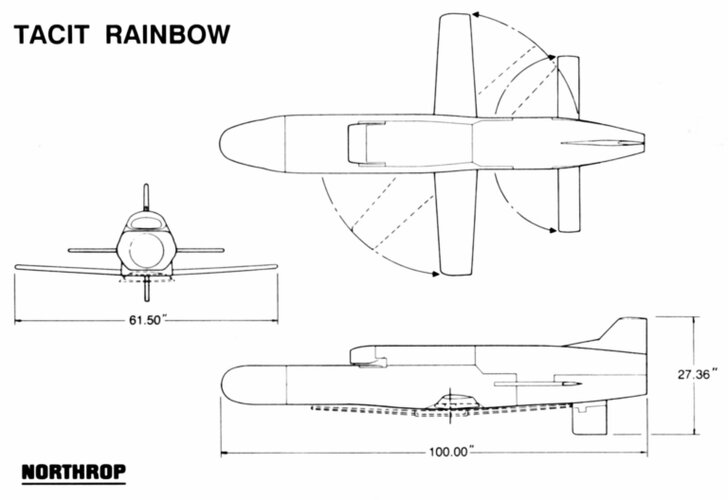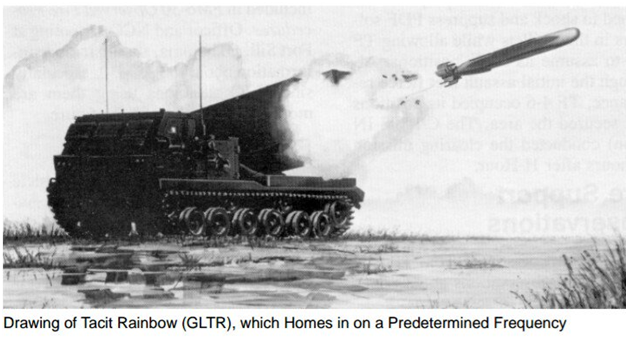McDonnell Douglas Ground Launched Tacit Rainbow mugs
AGM-136A Test Team patch
Was Northrop Grumman.
Ground Launched Tacit Rainbow was assigned to a team of Raytheon,
McDonnell Douglas and E-Systems.
Explore the full September 18 1989 issue of Aviation Week. Browse featured articles, preview selected issue contents, and more.

archive.aviationweek.com
Raytheon Team Selected to Develop Ground-Launched Tacit Rainbow
JOHN D. MORROCCO/WASHINGTON
The team of Raytheon, McDonnell Douglas and E-Systems has been selected to develop a ground-launched version of the Tacit Rainbow antiradar weapon for the U. S. Army. The Raytheon-led team also was picked to qualify as a second-source producer of the AGM—136A air-launched version of the weapon now produced by Northrop.
The contracts will be awarded by the Joint Tactical Autonomous Weapons Systems program office at the Air Force’s Aeronautical Systems Div., which runs the Tacit Rainbow program. The fixed-price incentive contracts are to be awarded following a Defense Acquisition Board meeting scheduled for the end of October.
Raytheon and its partners were selected over two other contracting teams led by Boeing and Northrop. Boeing was competing for both contracts while Northrop was competing to develop the ground— launched version. The selection was made 'based on weapons trade studies conducted by all three teams.
Raytheon’s Missile Systems Div. will act as systems integrator and develop the guidance system for both missiles. Mc- Donnell Douglas Missile Systems Co. is responsible for the airframe, payload and propulsion system. E-Systems Melpar Div. will develop the missile electronics for the ground-launched version.
Under the second source program, Northrop will transfer technical data on the AGM-l36A to Raytheon over the next one to two years, according to Chauncey P. Dewey, Jr., Tacit Rainbow program manager at Raytheon. The Air Force will then begin a 30~month program to evaluate and qualify the Raytheon design, including five flight tests.
Raytheon plans to use the same Texas Instruments seeker employed by Northrop for the testing program. Dewey said, however, the firm will eventually develop its own seeker. The Air Force plans to split missile purchases between Northrop and Raytheon in 1994. The two firms will then begin competing for annual production buys in 1995.
The ground-launched program is scheduled to enter full-scale development concurrently with the second-source effort. The Army plans to include in its development contract two low-rate initial production options. The first of these options will be exercised in mid-1992, before the 4-year full-scale development program is completed. The ground-launched version will be employed on the Multiple Launch Rocket System (MLRS), which the Army wants to use for all of its deep strike weapons. Both versions of the lethal missile are designed to loiter over a designated target area searching for hostile radar emitters.
NEW AIRFRAME DESIGN
Contractor flight tests are scheduled to begin in the fall of 1991. Dewey said the ground-launched version will include a brand new airframe design to make it compatible with the MLRS, as well as a new propulsion system developed by Teledyne. Dewey said he that contracts for both programs would be awarded in December, pending the outcome of the upcoming Defense Acquisition Board review.
The board will meet to determine whether to proceed with full-scale development of the ground-launched version. At the same time, it will review progress toward meeting requirements it imposed on the air-launched program late last year. The senior-level review group recommended against moving into low-rate initial production of the missile because of testing problems and set a series of testing criteria to be met before additional purchases could be made.
The testing program appears to be back on track, however, following the fourth successful test launch of the airlaunched AGM-l36A on Aug. 31 (AW&ST Sept. 11, p.33). The Air Force seems to be well on its way to meeting the requirement of successfully completing five of eight test launches by October. A total of 25 development and operational test launches are to be conducted from Navy A-6 aircraft and Air Force B—52 bombers. Air Force officials are hopeful that a decision to enter low—rate initial production of the missile could come in the second half of 1990. A key issue at the DAB meeting will be whether the Navy agrees to rejoin the program. The Navy dropped plans to procure the air—launched version of the missile but is continuing in the full-scale development portion of the program.
UNIT COST
Without Navy participation, the unit cost of the missile will increase by more than 20%, according to an official in the Pentagon’s tactical warfare programs office. Defense Dept. officials are hopeful of reaching some decision on Navy participation at the DAB meeting in order to complete work on the Fiscal 1991 budget. Initial budget requests from the individual military services were due
Sept. 15.
While questions about the affordability of Tacit Rainbow linger, the program was endorsed by a joint operational requirements study. The report, which assessed the operational and employment concepts of the loitering missile, expressed strong support for the program. Deputy Defense Secretary Donald J. Atwood has reviewed the report that is scheduled to be delivered to Defense Secretary Richard B. Cheney this week.
Raytheon and its partners were selected over two other contracting teams led by Boeing and Northrop



















